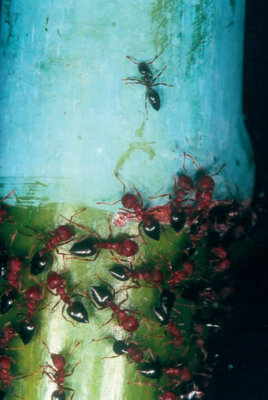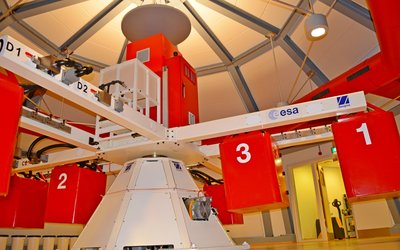Examples of past experiments
For more than 40 years most of the gravitational physiology studies on animals have been performed inside centrifuges. Initially mice, rats, dogs and chickens were investigated, but toads, rabbits, snakes and crickets later became subjects of study. Nearly all body systems were investigated and influenced by the increase in weight. In the last decade there has been increased interest in the application of chronic acceleration in the study of neuroplasticity, general animal behaviour and cognitive functions. [van Loon, Jack J.W. A.; Tanck, Esther; vanNieuwenhoven, Frans A.; Snoecks, Luc H. E. H.; deJong, Herman A. A.; Wubbels, Rene J.; Journal of Gravitational Physiology, Volume 12, Number 1; July 2005, pp. P5-P10]
![]()
Hypergravity Induces Phosphorylation of p53 at Serine 15, but not an Expression of p53-downstream Genes
The researchers investigated the p53 signalling pathway induced by hypergravity in the human glioblastoma cell line A 172. Hypergravity (20g) induced the accumulation of p53 and the phosphorylation of p53 at Ser-15. The phosphorylation of p53 with hypergravity was not inhibited by wortmannin, the PI3-kinase inhibitor. [Kumio Okaichi, Miwa IDE, Aya Usui and Yutaka Okumura, Journal of Radiation Research Vol. 45 (2004) , No. 3 399-403]
![]()
Centrifuges: evolution of their uses in plant gravitational biology and new directions for research on the ground and in spaceflight.
The aim of this experiment was to study how plants perceive and respond to a gravitational stimulus. It required experimental manipulation of the force or acceleration vector direction and magnitude. [Brown AH ,Gravitational Plant Physiology Laboratory, University City Science Center, Philadelphia, ASGSB Bull. 1992 Oct;5(2):43-57]
![]()
Vestibular-induced behaviour of rats born and raised in hypergravity.
In this work, one group of rats was bred and kept under hypergravity (HG) conditions (2.5 g) in a centrifuge. Another group was bred and kept under normal gravity conditions (1g). Rats from both groups were dropped from a supine position into a water basin under infrared illumination, leaving only gravity (1g for both groups) for orientation. The air-righting reflex and reappearance at the water surface were examined. [R. J. Wubbels and H. A. A. de Jong, Brain Research Bulletin, Volume 52, Issue 5, 15 July 2000, Pages 349-356]
![]()

Plasma physics experiments
In this study, Imaging Laser Absorption Spectroscopy (ILAS) was performed on a metal-halide lamp under hypergravity conditions in a centrifuge (acceleration ranging from 1 to 10g). Convection is induced by gravity, and measurement under different apparent gravity conditions aids the understanding of the flow processes in the lamp. [A.J. Flikweert et al., Imaging Laser Absorption Spectroscopy of the MH lamp (1–10g), Plasma Sources Sci. Technol. 16 (2007) 606–613]
![]()

Ants and plants symbiose
The symbiotic ant partners of glaucous Macaranga antplants show an exceptional capacity to run on the slippery epicuticular wax crystals covering the plant stem without any difficulty. In the study, the authors compared attachment on a smooth surface for 11 ant species with different wax-running capacities. The maximum force that could be withstood before an ant became detached was quantified using a centrifuge recorded by a high-speed video camera. [Federle et al., Attachment forces of ants measured with a centrifuge: better ‘wax-runners’ have a poorer attachment to a smooth surface, The Journal of Experimental Biology 203, 505–512 (2000)]
![]()
Convection patters of ciliates
Bioconvection is a result of the negative gravitactic behaviour of micro-organisms. In order to gain an insight into the hydrodynamic as well as biological dependence of the convective motion on gravity, they investigated changes in bioconvective patterns of Tetrahymena under altered gravity acceleration generated by a long-arm centrifuge. [Mogami et al., Bioconvective pattern formation of Tetrahymena under altered gravity, The Journal of Experimental Biology 207, 3349-3359, 2004]







